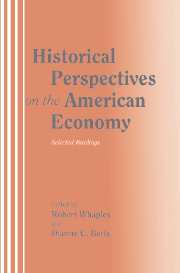Book contents
- Frontmatter
- Contents
- Acknowledgments
- Introduction to students
- Introduction to instructors
- Contributors
- I Introduction
- II Colonial and early national economy
- III Slavery and servitude
- IV The South since the Civil War
- V The rise of American industrial might
- VI Populism
- VII Women in the economy
- VIII The Great Depression
- Appendix: Basics of regression
- Glossary
- Name index
- Subject index
III - Slavery and servitude
Published online by Cambridge University Press: 05 June 2012
- Frontmatter
- Contents
- Acknowledgments
- Introduction to students
- Introduction to instructors
- Contributors
- I Introduction
- II Colonial and early national economy
- III Slavery and servitude
- IV The South since the Civil War
- V The rise of American industrial might
- VI Populism
- VII Women in the economy
- VIII The Great Depression
- Appendix: Basics of regression
- Glossary
- Name index
- Subject index
Summary
“The rise and fall of indentured servitude in the Americas: An economic analysis”
by David W. GalensonThe economic growth and development of the North American colonies depended on agriculture. To clear the abundant land and plant and harvest the crop, labor was needed. On small farms, the family supplied its own labor. The larger, commercial farms, however, demanded a greater labor supply. Because land was inexpensive, self-employment was common, and few laborers were willing to work for wages. Wage workers commanded relatively high compensation and often worked only long enough to save money to purchase their own land. A solution to this shortage was the importation of bound labor from the Old World.
While we all have some familiarity with the system of slavery, most of us are unfamiliar with another form of bound labor: indentured servitude. David Galenson demonstrates the importance of indentured servitude, noting that between the 1640s and the Revolution, over half of the European immigrants to the colonies arrived as indentured servants. Galenson's primary tasks in this essay are to explain the origins and early adaptations of indentured servitude, to unlock the economic logic of this institution, and to explain its rise, fall, rise, and fall in the Americas between 1620 and 1917.
The primary difference between slavery and indentured servitude was coercion. Indentured servitude was (almost always) entered into voluntarily; slavery was not. However, once the master–servant relationship was established, both systems developed an array of positive and negative incentives to elicit work from the servant.
- Type
- Chapter
- Information
- Historical Perspectives on the American EconomySelected Readings, pp. 107 - 109Publisher: Cambridge University PressPrint publication year: 1995



